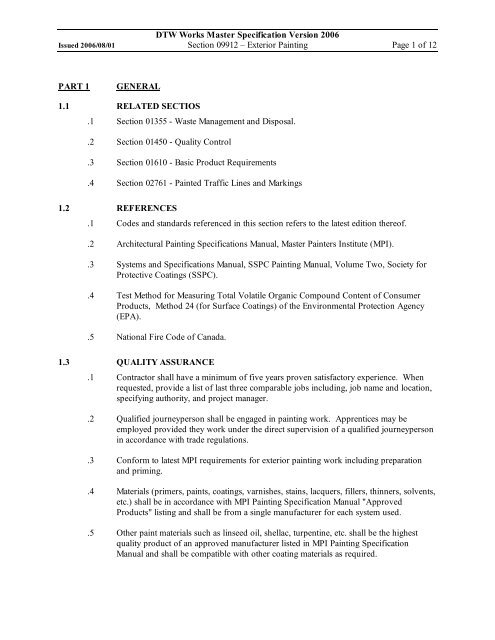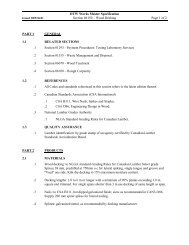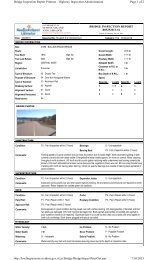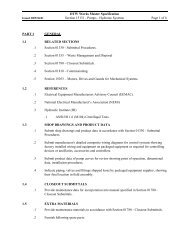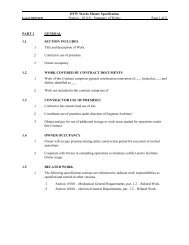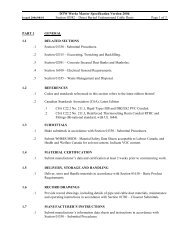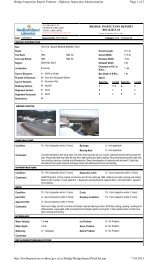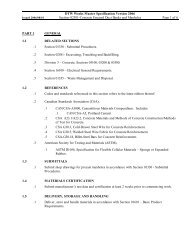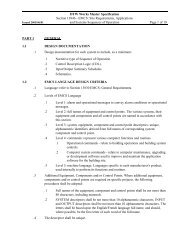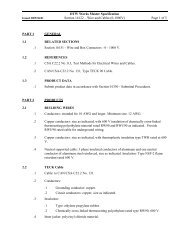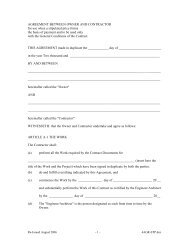Section #09912 - Exterior Painting - Department of Transportation ...
Section #09912 - Exterior Painting - Department of Transportation ...
Section #09912 - Exterior Painting - Department of Transportation ...
You also want an ePaper? Increase the reach of your titles
YUMPU automatically turns print PDFs into web optimized ePapers that Google loves.
DTW Works Master Specification Version 2006Issued 2006/08/01 <strong>Section</strong> 09912 –<strong>Exterior</strong> <strong>Painting</strong> Page 1 <strong>of</strong> 12PART 1GENERAL1.1 RELATED SECTIOS.1 <strong>Section</strong> 01355 Waste Management and Disposal..2 <strong>Section</strong> 01450 Quality Control.3 <strong>Section</strong> 01610 Basic Product Requirements.4 <strong>Section</strong> 02761 Painted Traffic Lines and Markings1.2 REFERENCES.1 Codes and standards referenced in this section refers to the latest edition there<strong>of</strong>..2 Architectural <strong>Painting</strong> Specifications Manual, Master Painters Institute (MPI)..3 Systems and Specifications Manual, SSPC <strong>Painting</strong> Manual, Volume Two, Society forProtective Coatings (SSPC)..4 Test Method for Measuring Total Volatile Organic Compound Content <strong>of</strong> ConsumerProducts, Method 24 (for Surface Coatings) <strong>of</strong> the Environmental Protection Agency(EPA)..5 National Fire Code <strong>of</strong> Canada.1.3 QUALITY ASSURANCE.1 Contractor shall have a minimum <strong>of</strong> five years proven satisfactory experience. Whenrequested, provide a list <strong>of</strong> last three comparable jobs including, job name and location,specifying authority, and project manager..2 Qualified journeyperson shall be engaged in painting work. Apprentices may beemployed provided they work under the direct supervision <strong>of</strong> a qualified journeypersonin accordance with trade regulations..3 Conform to latest MPI requirements for exterior painting work including preparationand priming..4 Materials (primers, paints, coatings, varnishes, stains, lacquers, fillers, thinners, solvents,etc.) shall be in accordance with MPI <strong>Painting</strong> Specification Manual "ApprovedProducts" listing and shall be from a single manufacturer for each system used..5 Other paint materials such as linseed oil, shellac, turpentine, etc. shall be the highestquality product <strong>of</strong> an approved manufacturer listed in MPI <strong>Painting</strong> SpecificationManual and shall be compatible with other coating materials as required.
DTW Works Master Specification Version 2006Issued 2006/08/01 <strong>Section</strong> 09912 –<strong>Exterior</strong> <strong>Painting</strong> Page 2 <strong>of</strong> 12.6 Retain purchase orders, invoices and other documents to prove conformance with notedMPI requirements when requested by Engineer/Architect..7 Standard <strong>of</strong> Acceptance:.1 Walls: No defects visible from a distance <strong>of</strong> 1000 mm at 90 ° to surface..2 Ceilings: No defects visible from floor at 45° to surface when viewed usingfinal lighting source..3 Final coat to exhibit uniformity <strong>of</strong> colour and uniformity <strong>of</strong> sheen across fullsurface area.1.4 ENVIRONMENTAL PERFORMANCE REQUIREMENTS.1 Provide paint products meeting MPI "Environmentally Friendly" E1, E2, E3, ratingsbased on VOC (EPA Method 24) content levels.1.5 SCHEDULING OF WORK.1 Submit work schedule for various stages <strong>of</strong> painting to Engineer/Architect for approval.Submit schedule minimum <strong>of</strong> 48 hours in advance <strong>of</strong> proposed operations..2 Obtain written authorization from Engineer/Architect for changes in work schedule..3 Schedule painting operations to prevent disruption <strong>of</strong> occupants in and about thebuilding.1.6 SUBMITTALS.1 Submit product data and manufacturer's installation/application instructions for paintsand coating products to be used in accordance with <strong>Section</strong> 01330 SubmittalProcedures..2 Submit WHMIS MSDS Material Safety Data Sheets..3 Upon completion, submit records <strong>of</strong> products used, records to be included in Operationand Maintenance Manuals. List products in relation to finish system and include thefollowing:.1 Product name, type and use..2 Manufacturer's product number..3 Colour numbers..4 Manufacturer's Material Safety Data Sheets (MSDS)..5 MPI Environmentally Friendly classification system rating..4 Submit manufacturer’s application instructions for each product specified.1.7 SAMPLES.1 Submit samples in accordance with <strong>Section</strong> 01330 Submittal Procedures.
DTW Works Master Specification Version 2006Issued 2006/08/01 <strong>Section</strong> 09912 –<strong>Exterior</strong> <strong>Painting</strong> Page 3 <strong>of</strong> 12.2 Submit duplicate 200 x 300 mm sample panels <strong>of</strong> each paint, stain, clear coating, withspecified paint or coating in colours, gloss/sheen and textures required to MPI <strong>Painting</strong>Specification Manual standards submitted on the following substrate materials:.1 3 mm plate steel for finishes over metal surfaces..2 13 mm birch plywood for finishes over wood surfaces..3 50 mm concrete block for finishes over concrete or concrete masonry surfaces..4 13 mm gypsum board for finishes over gypsum board and other smoothsurfaces..3 When approved, samples shall become acceptable standard <strong>of</strong> quality for appropriateonsite surface with one <strong>of</strong> each sample retained onsite..4 Submit full range <strong>of</strong> available colours where colour availability is restricted.1.8 QUALITY CONTROL.1 Provide mockup in accordance with <strong>Section</strong> 01450 Quality Control..2 When requested by the Engineer/Architect or Paint Inspection Agency, prepare and paintdesignated surface, area, room or item (in each colour scheme) to requirements specifiedherein, with specified paint or coating showing selected colours, gloss/sheen, texturesand workmanship to MPI <strong>Painting</strong> Specification Manual standards for review andapproval. When approved, surface, area, room and/or items shall become acceptablestandard <strong>of</strong> finish quality and workmanship for similar onsite work.1.9 EXTRA MATERIALS.1 Submit maintenance materials in accordance with <strong>Section</strong> 01780 Closeout Submittals..2 Submit 1 4 litre can <strong>of</strong> each type and colour <strong>of</strong> finish coating. Identify colour and painttype in relation to established colour schedule and finish formula..3 Deliver to Engineer/Architect and store where directed.1.10 DELIVERY, HANDLING AND STORAGE.1 Deliver, store and handle materials in accordance with <strong>Section</strong> 01610 Basic ProductRequirements..2 Deliver and store materials in original containers, sealed, with labels intact..3 Labels shall clearly indicate:.1 Manufacturer's name and address..2 Type <strong>of</strong> paint or coating..3 Compliance with applicable standard..4 Colour number in accordance with established colour schedule..4 Remove damaged, opened and rejected materials from site.
DTW Works Master Specification Version 2006Issued 2006/08/01 <strong>Section</strong> 09912 –<strong>Exterior</strong> <strong>Painting</strong> Page 4 <strong>of</strong> 12.5 Provide and maintain dry, temperature controlled, secure storage..6 Observe manufacturer's recommendations for storage and handling..7 Store materials and supplies away from heat generating devices..8 Store materials and equipment in a well ventilated area with temperature range 7ºC to30ºC..9 Store temperature sensitive products above minimum temperature as recommended bymanufacturer..10 Keep areas used for storage, cleaning and preparation, clean and orderly to approval <strong>of</strong>Consultant. After completion <strong>of</strong> operations, return areas to clean condition to approval<strong>of</strong> Consultant..11 Remove paint materials from storage only in quantities required for same day use..12 Comply with requirements <strong>of</strong> Workplace Hazardous Materials Information System(WHMIS) regarding use, handling storage, and disposal <strong>of</strong> hazardous materials..13 Fire Safety Requirements:.1 Provide one 9 kg Type ABC dry chemical fire extinguisher adjacent to storagearea..2 Store oily rags, waste products, empty containers and materials subject tospontaneous combustion in ULC approved, sealed containers and remove fromsite on a daily basis..3 Handle, store, use and dispose <strong>of</strong> flammable and combustible materials inaccordance with the National Fire Code <strong>of</strong> Canada..14 Comply with requirements <strong>of</strong> Workplace Hazardous Materials Information System(WHMIS) regarding use, handling, storage, and disposal <strong>of</strong> hazardous materials.1.11 SITE REQUIREMENTS.1 Heating, Ventilation and Lighting:.1 Ventilate enclosed spaces..2 Perform no painting work unless adequate and continuous ventilation andsufficient heating facilities are in place to maintain ambient air and substratetemperatures above 10ºC for 24 hours before, during and after paint applicationuntil paint has cured sufficiently..3 Where required, provide continuous ventilation for seven days after completion<strong>of</strong> application <strong>of</strong> paint..4 Provide temporary ventilating and heating equipment where permanent facilitiesare not available.
DTW Works Master Specification Version 2006Issued 2006/08/01 <strong>Section</strong> 09912 –<strong>Exterior</strong> <strong>Painting</strong> Page 5 <strong>of</strong> 12.5 Perform no painting work unless a minimum lighting level <strong>of</strong> 323 Lux isprovided on surfaces to be painted. Adequate lighting facilities shall beprovided by General Contractor..2 Temperature, Humidity and Substrate Moisture Content Levels:.1 Unless specifically preapproved by Engineer/Architect and, applied productmanufacturer, perform no painting work when:.1 ambient air and substrate temperatures are below 10ºC..2 substrate temperature is over 32ºC unless paint is specifically formulatedfor application at high temperatures..3 substrate and ambient air temperatures are expected to fall outside MPIor paint manufacturer's prescribed limits..4 the relative humidity is above 85% or when dew point is less than 3ºCvariance between air/surface temperature..5 rain or snow are forecast to occur before paint has thoroughly cured orwhen it is foggy, misty, raining or snowing at site..2 Perform no painting work when maximum moisture content <strong>of</strong> substrateexceeds:.1 12% for concrete and masonry (clay and concrete brick/block)..2 15% for wood..3 12% for plaster and gypsum board..3 Conduct moisture tests using a properly calibrated electronic Moisture Meter,except test concrete floors for moisture using a simple "cover patch test"..4 Test concrete, masonry and plaster surfaces for alkalinity as required..3 Surface and Environmental Conditions:.1 Apply paint finish only in areas where dust is no longer being generated byrelated construction operations or when wind or ventilation conditions are suchthat airborne particles will not affect quality <strong>of</strong> finished surface..2 Apply paint only to adequately prepared surfaces and to surfaces withinmoisture limits noted herein..3 Apply paint only when previous coat <strong>of</strong> paint is dry or adequately cured..4 Apply paint finishes only when conditions forecast for entire period <strong>of</strong>application fall within manufacturer's recommendations..5 Do not apply paint when:.1 Temperature is expected to drop below 10ºC before paint hasthoroughly cured..2 Substrate and ambient air temperatures are expected to fall outside MPIor paint manufacturer's limits..3 Surface to be painted is wet, damp or frosted..6 Provide and maintain cover when paint must be applied in damp or coldweather. Heat substrates and surrounding air to comply with temperature andhumidity conditions specified by manufacturer. Protect until paint is dry or untilweather conditions are suitable.
DTW Works Master Specification Version 2006Issued 2006/08/01 <strong>Section</strong> 09912 –<strong>Exterior</strong> <strong>Painting</strong> Page 6 <strong>of</strong> 12.7 Schedule painting operations such that surfaces exposed to direct, intensesunlight are scheduled for completion during early morning..8 Remove paint from areas which have been exposed to freezing, excess humidity,rain, snow or condensation. Prepare surface again and repaint..9 Paint occupied facilities in accordance with approved schedule only. Scheduleoperations to approval <strong>of</strong> the Engineer/Architect such that painted surfaces willhave dried and cured sufficiently before occupants are affected.PART 2PRODUCTS2.1 MATERIALS.1 Paint materials listed in the latest edition <strong>of</strong> the MPI Approved Products List (APL) areacceptable for use on this project..2 Paint materials for each coating formula to be products <strong>of</strong> a single manufacturer..3 Low odour products: whenever possible, select products exhibiting low odourcharacteristics. If two products are otherwise equivalent, select the product with thelowest odour. Only qualified products with E2 or E3 "Environmentally Friendly" ratingare acceptable for use on this project..4 Paints, coatings, adhesives, solvents, cleaners, lubricants, and other fluids, shall:.1 be waterbased, water soluble, water cleanup..2 be nonflammable.3 be manufactured without compounds which contribute to ozone depletion in theupper atmosphere..4 be manufactured without compounds which contribute to smog in the loweratmosphere..5 do not contain methylene chloride, chlorinated hydrocarbons, toxic metalpigments..5 Waterborne surface coatings must be manufactured and transported in a manner thatsteps <strong>of</strong> processes, including disposal <strong>of</strong> waste products arising therefrom, will meetrequirements <strong>of</strong> applicable governmental acts, bylaws and regulations including, forfacilities located in Canada, Fisheries Act and Canadian Environmental Protection Act(CEPA)..6 Waterborne surface coatings must not be formulated or manufactured with aromaticsolvents, formaldehyde, halogenated solvents, mercury, lead, cadmium, hexavelantchromium or their compounds..7 Waterborne surface coatings must have a flash point <strong>of</strong> 61.0ºC or greater..8 Both waterborne surface coatings and recycled waterborne surface coatings must bemade by a process that does not release:
DTW Works Master Specification Version 2006Issued 2006/08/01 <strong>Section</strong> 09912 –<strong>Exterior</strong> <strong>Painting</strong> Page 7 <strong>of</strong> 12.1 Matter in undiluted production plant effluent generating a 'Biochemical OxygenDemand' (BOD) in excess <strong>of</strong> 15 mg/L to a natural watercourse or a sewagetreatment facility lacking secondary treatment..2 Total Suspended Solids (TSS) in undiluted production plant effluent in excess<strong>of</strong> 15 mg/L to a natural watercourse or a sewage treatment facility lackingsecondary treatment..9 Waterborne paints and stains, and water borne varnishes must meet a minimum"Environmentally Friendly" E2 rating.2.2 COLOURS.1 Engineer/Architect will provide Colour Schedule after Contract award..2 Selection <strong>of</strong> colours will be from manufacturers full range <strong>of</strong> colours..3 Where specific products are available in a restricted range <strong>of</strong> colours, selection will bebased on the limited range..4 Second coat in a three coat system to be tinted slightly lighter colour than top coat toshow visible difference between coats.2.3 MIXING AND TINTING.1 Perform colour tinting operations prior to delivery <strong>of</strong> paint to site. Onsite tinting <strong>of</strong>painting materials is allowed only with Engineers/Architect written permission..2 Paste, powder or catalyzed paint mixes shall be mixed in strict accordance withmanufacturer's written instructions..3 Where thinner is used, addition shall not exceed paint manufacturer's recommendations.Do not use kerosene or any such organic solvents to thin waterbased paints..4 Thin paint for spraying according in strict accordance with paint manufacturer'sinstructions. If directions are not on container, obtain instructions in writing frommanufacturer and provide copy <strong>of</strong> instructions to Engineer/Architect..5 Remix paint in containers prior to and during application to ensure breakup <strong>of</strong> lumps,complete dispersion <strong>of</strong> settled pigment, and colour and gloss uniformity.
DTW Works Master Specification Version 2006Issued 2006/08/01 <strong>Section</strong> 09912 –<strong>Exterior</strong> <strong>Painting</strong> Page 8 <strong>of</strong> 122.4 GLOSS/SHEEN RATINGS.1 Paint gloss shall be defined as the sheen rating <strong>of</strong> applied paint, in accordance with thefollowing values:Gloss Level /Category Units @ 60E/ Units @ 85ºG1 matte finish 0 to 5 max. 10G2 velvet finish 0 to 10 10 to 35G3 eggshell finish 10 to 25 10 to 35G4 satin finish 20 to 35 min. 35G5 semigloss finish 35 to 70G6 – gloss finish 70 to 85G7 high gloss finish > 85.2 Gloss level ratings <strong>of</strong> painted surfaces shall be as specified herein.2.5 EXTERIOR PAINTING SYSTEMS.1 Asphalt Surfaces: zone/traffic marking for drive and parking areas, etc..1 EXT 2.1B Alkyd zone/traffic marking finish..2 Concrete Vertical Surfaces: (including horizontal s<strong>of</strong>fits).1 EXT 3.1A –Latex G4 finish.3 Concrete Horizontal Surfaces: decks.1 EXT 3.2D Alkyd floor enamel G4 finish..4 Clay Masonry Units: (pressed and extruded brick).1 EXT 4.1A Latex G4 finish..5 Concrete Masonry Units: smooth and split face block and brick.1 EXT 4.2A Latex G4 finish..6 Structural Steel and Metal Fabrications:.1 EXT 5.1F Epoxy finish..7 Galvanized Metal: not chromate passivated.1 EXT 5.3B Alkyd G6 finish..8 Dimension Lumber: columns, beams, exposed joists, underside <strong>of</strong> decking, siding,fencing, etc..1 EXT 6.2L Semitransparent stain finish..2 EXT 6.2M Latex G4 finish (over latex primer)..9 Dressed Lumber: doors, door and window frames, casings, battens, smooth facias, etc..1 EXT 6.3L Latex G4 finish (over latex primer).10 Wood Panelling: plywood siding, fascias, s<strong>of</strong>fits, etc.
DTW Works Master Specification Version 2006Issued 2006/08/01 <strong>Section</strong> 09912 –<strong>Exterior</strong> <strong>Painting</strong> Page 9 <strong>of</strong> 12.1 EXT 6.4K Latex G4 finish (over latex primer)..11 Wood Decks and Stairs/Steps: using spaced lumber.1 EXT 6.5A Latex porch and floor G4 finish (over primer)..2 EXT 6.5F Deck stain finish.PART 3EXECUTION3.1 GENERAL.1 Perform preparation and operations for exterior painting in accordance with MPI<strong>Painting</strong> Specifications Manual except where specified otherwise..2 Apply all paint materials in accordance with paint manufacturer's written applicationinstructions.3.2 EXISTING CONDITIONS.1 Investigate existing substrates for problems related to proper and complete preparation<strong>of</strong> surfaces to be painted. Report to Engineer/Architect damages, defects, unsatisfactoryor unfavourable conditions before proceeding with work..2 Conduct moisture testing <strong>of</strong> surfaces to be painted using a properly calibrated electronicmoisture meter, except test concrete floors for moisture using a simple "cover patch test"and report findings to Engineer/Architect. Do not proceed with work until conditionsfall within acceptable range as recommended by manufacturer..3 Maximum moisture content as follows:.1 Concrete: 12%..2 Clay and Concrete Block/Brick: 12%..3 Wood: 15%.3.3 PROTECTION.1 Protect existing building surfaces and adjacent structures from paint spatters, markingsand other damage by suitable nonstaining covers or masking. If damaged, clean andrestore such surfaces as directed by Engineer/Architect..2 Cover or mask windows and other ornamental hardware adjacent to areas being paintedto prevent damage and to protect from paint drops and splatters. Use nonstainingcoverings..3 Protect items that are permanently attached such as Fire Labels on doors and frames..4 Protect factory finished products and equipment..5 Protect passing pedestrians, building occupants and general public in and about thebuilding.
DTW Works Master Specification Version 2006Issued 2006/08/01 <strong>Section</strong> 09912 –<strong>Exterior</strong> <strong>Painting</strong> Page 10 <strong>of</strong> 12.6 Remove electrical cover plates, light fixtures, surface hardware on doors, and all othersurface mounted fittings, equipment and fastenings prior to undertaking any paintingoperations. Store for reinstallation after painting is completed..7 Cover or move exterior furniture and portable equipment around building as necessaryto carry out painting operations. Replace as painting operations progress..8 As painting operations progress, place "WET PAINT" signs in areas <strong>of</strong> work toapproval <strong>of</strong> Engineer/Architect.3.4 CLEANING AND PREPARATION.1 Clean and prepare exterior surfaces in accordance with MPI <strong>Painting</strong> SpecificationManual requirements. Refer to the MPI Manual in regard to specific requirements andas follows:.1 Remove dust, dirt, and other surface debris by wiping with dry, clean cloths orcompressed air..2 Wash surfaces with a biodegradable detergent and bleach where applicable andclean warm water using a stiff bristle brush to remove dirt, oil and other surfacecontaminants..3 Rinse scrubbed surfaces with clean water until foreign matter is flushed fromsurface..4 Allow surfaces to drain completely and allow to dry thoroughly..5 Prepare surfaces for waterbased painting, waterbased cleaners should be usedin place <strong>of</strong> organic solvents..6 Use trigger operated spray nozzles for water hoses..7 Many waterbased paints cannot be removed with water once dried. However,minimize the use <strong>of</strong> kerosene or any such organic solvents to clean up waterbasedpaints..2 Prevent contamination <strong>of</strong> cleaned surfaces before prime coat is applied and betweenapplications <strong>of</strong> remaining coats. Apply primer, paint, or pretreatment as soon aspossible after cleaning and before deterioration occurs..3 Where possible, prime surfaces <strong>of</strong> new wood surfaces before installation. Use sameprimers as specified for exposed surfaces..1 Apply vinyl sealer to MPI #36 over knots, pitch, sap and resinous areas..2 Apply wood filler to nail holes and cracks..3 Tint filler to match stains for stained woodwork..4 Sand and dust between coats as required to provide adequate adhesion for next coat andto remove defects visible from a distance up to 1000 mm..5 Clean metal surfaces to be painted by removing rust, loose mill scale, welding slag, dirt,oil, grease and other foreign substances in accordance with MPI requirements. Removetraces <strong>of</strong> blast products from surfaces, pockets and corners to be painted by brushingwith clean brushes or blowing with clean dry compressed air.
DTW Works Master Specification Version 2006Issued 2006/08/01 <strong>Section</strong> 09912 –<strong>Exterior</strong> <strong>Painting</strong> Page 11 <strong>of</strong> 12.6 Touch up <strong>of</strong> shop primers with primer as specified in applicable section. Major touchupincluding cleaning and painting <strong>of</strong> field connections, welds, rivets, nuts, washers,bolts, and damaged or defective paint and rusted areas, shall be by supplier <strong>of</strong> fabricatedmaterial..7 Do not apply paint until prepared surfaces have been accepted by Engineer/Architect.3.5 APPLICATION.1 Method <strong>of</strong> application to be as approved by Engineer/Architect. Apply paint by brushroller, air sprayer, airless sprayer. Conform to manufacturer's application instructionsunless specified otherwise..2 Brush and Roller Application:.1 Apply paint in a uniform layer using brush and/or roller <strong>of</strong> types suitable forapplication..2 Work paint into cracks, crevices and corners..3 Paint surfaces and corners not accessible to brush using spray, daubers and/orsheepskins. Paint surfaces and corners not accessible to roller using brush,daubers or sheepskins..4 Brush and/or roll out runs and sags, and overlap marks. Rolled surfaces shallbe free <strong>of</strong> roller tracking and heavy stipple..5 Remove runs, sags and brush marks from finished work and repaint..3 Spray Application:.1 Provide and maintain equipment that is suitable for intended purpose, capable <strong>of</strong>properly atomizing paint to be applied, and equipped with suitable pressureregulators and gauges..2 Keep paint ingredients properly mixed in containers during paint applicationeither by continuous mechanical agitation or by intermittent agitation asfrequently as necessary..3 Apply paint in a uniform layer, with overlapping at edges <strong>of</strong> spray pattern..4 Brush out immediately runs and sags..5 Use brushes to work paint into cracks, crevices and places which are notadequately painted by spray..4 Use dipping, sheepskins or daubers only when no other method is practical in places <strong>of</strong>difficult access and only when specifically authorized by Engineer/Architect..5 Apply coats <strong>of</strong> paint as a continuous film <strong>of</strong> uniform thickness. Repaint thin spots orbare areas before next coat <strong>of</strong> paint is applied..6 Allow surfaces to dry and properly cure after cleaning and between subsequent coats forminimum time period as recommended by manufacturer..7 Sand and dust between coats to remove visible defects.
DTW Works Master Specification Version 2006Issued 2006/08/01 <strong>Section</strong> 09912 –<strong>Exterior</strong> <strong>Painting</strong> Page 12 <strong>of</strong> 12.8 Finish surfaces both above and below sight lines as specified for surrounding surfaces,including such surfaces as projecting ledges..9 Finish top, bottom, edges and cutouts <strong>of</strong> doors after fitting as specified for doorsurfaces.3.6 MECHANICAL/ELECTRICAL EQUIPMENT.1 Unless otherwise specified, paint exterior exposed conduits, piping, hangers, ductworkand other mechanical and electrical equipment with colour and finish to match adjacentsurfaces, except as noted otherwise..2 Touch up scratches and marks on factory painted finishes and equipment with paint assupplied by manufacturer <strong>of</strong> equipment..3 Paint fire protection piping red..4 Do not paint over nameplates..5 Paint steel electrical light standards. Do not paint outdoor transformers and substationequipment.3.7 FIELD QUALITY CONTROL.1 Field inspection <strong>of</strong> exterior painting operations to be carried out by Engineer/Architect..2 Advise Engineer/Architect when each applied coating is ready for inspection. Do notproceed with subsequent coats until previous coat has been approved..3 Cooperate with Engineer/Architect and provide access to areas <strong>of</strong> work.3.8 RESTORATION.1 Clean and reinstall all hardware items removed before undertaken painting operations..2 Remove protective coverings and warning signs as soon as practical after operationscease..3 Remove paint splashings on exposed surfaces that were not painted. Remove smearsand spatter immediately as operations progress, using compatible solvent..4 Protect surfaces from paint droppings and dust to approval <strong>of</strong> Engineer/Architect.Avoid scuffing newly applied paint..5 Restore areas used for storage, cleaning, mixing and handling <strong>of</strong> paint to clean conditionas approved by Engineer/Architect.END OF SECTION


